
Guests
- Kevin MooreBaltimore resident and member of WeCopwatch, who documented Freddie Gray’s final moments before being taken into police custody.
Links
Baltimore Mayor Stephanie Rawlings-Blake announced Friday that she would not be seeking re-election in the city’s 2016 mayoral race so that she could focus on governing a city on edge over the trials of six police officers charged in the death of Freddie Gray, an African-American man who died in April after being arrested and transported in a police van. The announcement came at the end of a week that saw several developments in the case. On Thursday, Judge Barry Williams ruled that the six officers charged in Gray’s death will face separate trials. Williams also refused defense attempts to dismiss the charges, move the case out of Baltimore, and remove prosecutor Marilyn Mosby from the case. And earlier in the week, the city reached a $6.4 million settlement with Gray’s family. A key piece of evidence in the case against the officers is the video showing Gray screaming in apparent agony as police drag him to a van. It was shot by Kevin Moore, a Baltimore resident who lives in the Gilmor Homes housing projects where Freddie Gray lived. We speak with Moore, who, after filming the event, became a member of WeCopwatch, a nationwide effort to reduce police violence and harassment by videotaping encounters with the community. He also founded a WeCopwatch chapter in Baltimore.
Transcript
AMY GOODMAN: Baltimore Mayor Stephanie Rawlings-Blake announced she will not seek re-election in the city’s 2016 mayoral race, so that she can focus on governing a city on the edge over the trials of six police officers charged in the death of Freddie Gray, an African-American man who died in April after being arrested and transported in a police van. Rawlings-Blake made the announcement on Friday.
MAYOR STEPHANIE RAWLINGS-BLAKE: We all know that this is a very critical time in our city. Many important decisions lie ahead, both in recovering from April’s unrest and managing our city through the multiple trials that are coming up. Over the past few months, as I’ve been making plans for what I know is a vigorous campaign, I realized that every moment that I spent planning for a campaign or a re-election was a time that I was taking away from my current responsibilities to the city, to the city that I love and a city that I took an oath to serve. And because of that, I have made the decision not to seek re-election.
AMY GOODMAN: The announcement came at the end of a week that saw several developments in the Freddie Gray case. On Thursday, Judge Barry Williams ruled the six officers charged in his death will face separate trials. Williams also refused defense attempts to dismiss the charges, move the case out of Baltimore and remove prosecutor Marilyn Mosby from the case. And earlier in the week, Baltimore reached a $6.4 million settlement with the family of Freddie Gray. Gray’s family said his voice box was crushed, his spine 80 percent severed at the neck. Police said they arrested Gray for making eye contact with them, then running away.
Well, one key piece of evidence in the case against the officers in the Freddie Gray case is the video shot by our first guest today. It went viral, showing Gray screaming in apparent agony as police drag him to a van.
BYSTANDER: Hey! His leg looks broke! Look at his [bleep] leg! Look at his [bleep] leg! That boy’s leg looks broke! His leg’s broken! Y’all dragging him like that!
AMY GOODMAN: Kevin Moore, the man who shot the video, joins us today. The Baltimore resident lives in the Gilmor housing projects where Freddie Gray lived, was one of the people who documented Gray’s final moments before being taken into police custody. After filming the event, Kevin became a member of WeCopwatch, a nationwide effort to reduce police violence and harassment by videotaping encounters with the community. He also founded a WeCopwatch chapter in Baltimore.
Welcome to Democracy Now! It’s great to have you with us, Kevin.
KEVIN MOORE: Good morning, Amy. Thank you so much.
AMY GOODMAN: So, let’s talk about what happened on April 12th in the morning. Where were you when Freddie Gray was being arrested?
KEVIN MOORE: That morning, I was in bed. I was sleeping. And—
AMY GOODMAN: It was a Sunday morning.
KEVIN MOORE: It was a Sunday morning, yes. It was, I think, like 9:00, 9:30-ish. And yeah, I was sleeping, and somebody came hollering. They were yelling, “They’re tasing him! They’re tasing him!” And so, I hopped up out the bed, and I grabbed my hoodie and my pants and my phone, and I was out the door.
AMY GOODMAN: And what did you do?
KEVIN MOORE: Well, initially, from the side I was on, I couldn’t see anything. And all I could see was that they had someone pinned to the ground and that it was really—it was really brutal. It looked like it hurt, you know? And then, so once I crossed around and saw that it was Freddie, I was shocked.
AMY GOODMAN: You knew Freddie.
KEVIN MOORE: Oh, Freddie was a friend of mine. Freddie was a friend of a lot of people there in that area, in that community. And when it happened to him, when I first saw him, I’m like, “Wow! Oh, my god! It’s happening here right now in front of me.” And so—
AMY GOODMAN: Had you filmed before?
KEVIN MOORE: Never. Never, never, never. I was always witnessing or, you know, there for police brutality, and—but the Freddie Gray incident was the first time I ever picked up a camera and actually pushed it this far, you know?
AMY GOODMAN: Now, “picked up a camera,” you mean your cellphone?
KEVIN MOORE: Yeah, yes, absolutely.
AMY GOODMAN: And where were you as they were—and what were they doing to Freddie? What were you seeing through your cellphone?
KEVIN MOORE: I was in the street on—it’s a street called Presbury, and I was in the middle of the street, and I could see he was handcuffed. And like, they had the heels of his feet in his back, in the middle of his back almost. And—
AMY GOODMAN: What do you mean?
KEVIN MOORE: I mean, like the heels of your feet—picture the heels of your feet almost in the middle of your back, but the wrong way. And it just looked like a pretzel almost. And the one officer had his knee like buried right into his neck. And I could—you could hear him screaming, man. You could hear the pain in his voice, and on his face, you could see it. And then, when they picked him up and, you know, drug him to the van, you could see he couldn’t—he had no control of his legs or wasn’t able to stand or—you know, which is why they dragged from one point to the other. So…
AMY GOODMAN: And you just filmed him going into the van—
KEVIN MOORE: Yeah.
AMY GOODMAN: —being dragged into the van.
KEVIN MOORE: Yes, absolutely.
AMY GOODMAN: And then what happened?
KEVIN MOORE: After that, they pulled around on Mount Street and Baker Street, and they pulled him out again to—what they said was, to place leg shackles on him. But clearly, as you saw in the last video, that he had no leg life. He couldn’t use his legs, you know what I’m saying? So, what was the reason, in fact, for you to put the leg shackles on him?
AMY GOODMAN: So, what did you then do with that video? He’s taken away.
KEVIN MOORE: Yes.
AMY GOODMAN: Where did you go?
KEVIN MOORE: I went straight to Internal Affairs.
AMY GOODMAN: You went to the police?
KEVIN MOORE: Yeah, I went straight to, well, the people—I was ignorant at the time, right? So I didn’t know. So, in my mind, I’m thinking that the Internal Affairs, this is their job, you know, to police the police, right? So this is before I knew anything about the Copwatch, WeCopwatch. And so, I’m there, and I’m in Internal Affairs headquarters, and I’m sitting, and I’m waiting. They had my phone. They’re recording me [inaudible]—
AMY GOODMAN: You gave them your phone?
KEVIN MOORE: Absolutely.
AMY GOODMAN: Did you have a backup of the video?
KEVIN MOORE: Absolutely not.
AMY GOODMAN: And how long were you there?
KEVIN MOORE: I want to say upward of seven hours, eight hours, something like that.
AMY GOODMAN: Seven hours.
KEVIN MOORE: Yeah, absolutely. And they recorded me, audio and video. And I gave them the video. And once I got back to where I lived at the time, I called every news media outlet I could imagine. Me and a couple of people around the community and a friend of mine, Kiona Mack, she filmed the second half of the video. And we pushed it. We got together, and we called like everybody. And we YouTubed it and tried to just do what I thought Internal Affairs was taking too long to.
AMY GOODMAN: Did the police see you filming?
KEVIN MOORE: Oh, yeah, absolutely.
AMY GOODMAN: Did they try to stop you?
KEVIN MOORE: Absolutely. In the video, they tell me to stop recording. And, you know, I told them right then and there, “Hey, man, I’ve been recording this, you know, and I’m not going to stop it.” And then he tells me to, “Well, back up.” “OK, sure, I can back up, but I’m not going to stop recording, because it’s a First Amendment right, and I do have that. I am entitled to it.” So…
AMY GOODMAN: So you go to the police for seven hours. They film you talking about what you saw, and they also made a copy of your video.
KEVIN MOORE: Absolutely.
AMY GOODMAN: But you did get the video back.
KEVIN MOORE: Yes, I did.
AMY GOODMAN: It’s remained on your cellphone.
KEVIN MOORE: Remained intact in the same way I gave it to them.
AMY GOODMAN: People may not know your face, but that video has been seen all over the world. Can you talk about what that meant to you? That was April 12th, when Freddie was first taken. He died one week later. You got that video out within that time. And the response—well, you might say that is the reason six police officers have been indicted for the death of Freddie Gray.
KEVIN MOORE: Yeah.
AMY GOODMAN: Your reaction to that?
KEVIN MOORE: It’s surreal almost. It’s like I’m dreaming, kind of. Again, I’ve been through so much personally in my life in West Baltimore. It’s just a hard place to grow up in, you know? And basic survival is all we concentrate on, you know? So, in light of that, it’s like, what do you do when you’re placed in a position where you have people that are supposed to come and serve and protect in the police, right, but you can’t trust them because they brutalize people, they hurt people, they dehumanize people? You know what I’m saying? And it’s very belittling to me when you say we’re supposed to trust you, when you can come out with the police bill of rights and protect these animals from the very laws that they break. It’s amazing to me.
AMY GOODMAN: So, you had never done this before, but Copwatch got in touch with you after?
KEVIN MOORE: Absolutely, like immediately after they saw the Freddie Gray video, and there was like a few days into what was going on, and they came out, and they got in contact with me. And we went out and got—they brought me cameras and set up a nonprofit GoFundMe. And then, it was just—it was so much love.
AMY GOODMAN: And what has been the police reaction to you since?
KEVIN MOORE: Oh, man, it’s amazing how I can keep them at bay, so to speak, keep them on a leash with just a video camera. It’s almost like live ammunition, almost with like live rounds, live bullets from a gun. When you put a camera in a cop’s face, and he sees you, you know, he’s like, “Oh, wow, what do I do now?” you know, because at first his mindset was, “Oh, I can do whatever I want, and I’m a police, so I’ll get away with it.” But then, once he sees a civilian recording, and it’s raw footage and not CCTV, which can be tampered with, a body camera, which can be tampered with—
AMY GOODMAN: Closed-circuit.
KEVIN MOORE: You know what I’m saying? When it’s raw and it’s untouched, you know what I mean, it means so much more.
AMY GOODMAN: Do you think the police would have been indicted without the video evidence of what happened to Freddie, seeing him dragged?
KEVIN MOORE: Absolutely not, when history tells it that they don’t—they are not held responsible and accountable for the acts that—I mean, look at Rodney King. You know what I’m saying? And nothing has changed since then. And that’s the hurtful part.
AMY GOODMAN: And your response to the mayor, Stephanie Rawlings-Blake, announcing she will not be running for mayor, many saying it’s because of the criticism she received in the aftermath of the Freddie Blake—in the Freddie Gray killing?
KEVIN MOORE: What I don’t understand is for Mayor Stephanie Rawlings-Blake to say, “I’m taking—I’m not going to run, I’m not going to race in this mayoral campaign, because I want to focus on the city and the needs of the communities.” Isn’t this your job already as the mayor, to focus on the city and to show the love and support and the need to get these people what they need? This is what you’re supposed to been doing. So why is it that you’re—is that the reason, you know what I’m saying, that you’re not running?
AMY GOODMAN: You’re saying that’s the reason you should run.
KEVIN MOORE: That’s the reason that you should run.
AMY GOODMAN: What is your reaction to the settlement, the city’s settlement with Freddie Gray’s family, your neighbor in the Gilmor houses, $6.5 million settlement?
KEVIN MOORE: What, I mean—OK, so here’s the thing. Money is not parallel or an extension of justice. Right? So, in that sense, it’s like, OK, you gave them money, but don’t you think with that $6.5 million, if they could, they would go and purchase their son back? You know, so it’s like—it’s like, OK, with that, I’m so grateful that I was able to help you live life easier without your son, you know, and the people that helped push the whole Freddie Gray movement in Baltimore helped you live life a little easier knowing that you will never see your son again, knowing that you will never get your loved one back, and that even if you wanted to spend that whole $6.5 million to get him back, that you couldn’t.
AMY GOODMAN: And finally, did the police go after you after the film?
KEVIN MOORE: Oh, yeah.
AMY GOODMAN: Did they take you in?
KEVIN MOORE: Oh, yeah, they locked me up, and me and two of my brothers from Ferguson. And still to this day, I get harassed, and police sit outside my son’s school. And they ride past taunting me with their phones up. I’m Copwatching, and it’s just—it’s—
AMY GOODMAN: Are you afraid?
KEVIN MOORE: What, for my life? Well, no. I’m more so afraid for my family than myself, actually. You know, if they’re OK, then I’m fine. You know, I feel as though my name is out there far enough to where the people—if anything happened to me, the people will know where it came from, you know? And just know that if I do end up dead today or tomorrow, that I didn’t kill myself, and that if I do end up locked up, that I didn’t commit suicide. You know what I’m saying?
AMY GOODMAN: But you’re going to keep filming?
KEVIN MOORE: Oh, yeah. Oh, yeah. I didn’t start this Gilmor Homes patrolmen for nothing. I didn’t start the WeCopwatch in Baltimore just to—for the Freddie Gray movement. It’s so much bigger than Freddie Gray, and it’s because police brutality is across the world. I was talking to some friends from Brazil last night, and it brought me to tears to actually see the footage. And here I thought I had it bad. You know what I’m saying? And then, to see that, it’s like almost Third Worldly.
AMY GOODMAN: I want to thank you very much for being with us. Kevin Moore, Baltimore resident, lives in the Gilmor housing projects, one of the people who documented Freddie Gray’s final moments before being taken into police custody. Kevin is now a member of WeCopwatch, a nationwide effort to reduce police violence and harassment by videotaping encounters with the community, founder of WeCopwatch in Baltimore.
This is Democracy Now! When we come back, we go to Seattle, where there’s the first teachers’ strike going on in 30 years. Stay with us.



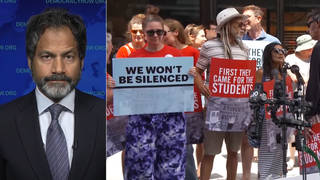
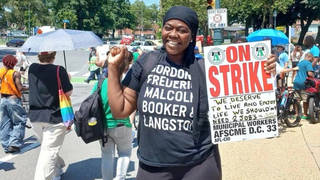

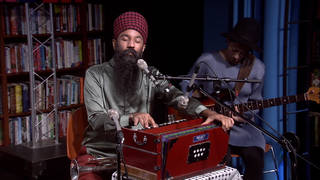

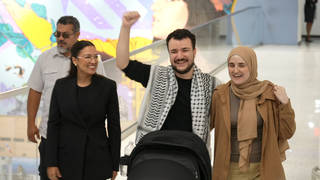

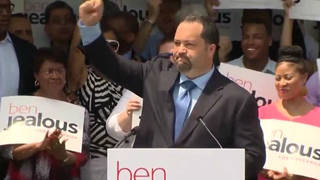

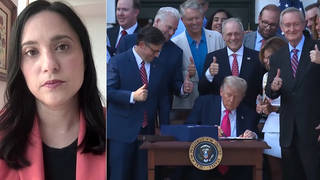
Media Options